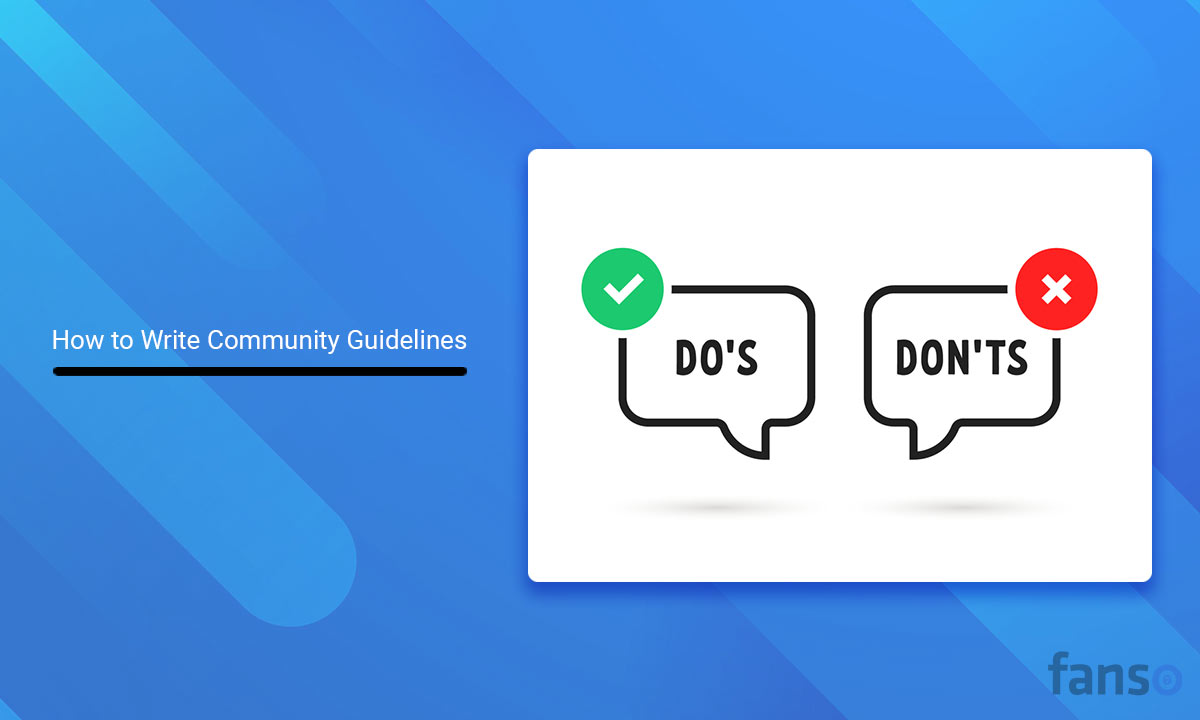An online community is a collective experience weaved by ideas, interactions, and knowledge. Thus, fall-outs, differences of opinion and tirades are natural!
Setting guidelines is crucial if you wish to stay focused on your community purpose. This ensures that every member is welcomed and has a safe and peaceful environment.
It’s a powerful aid for all members to stay on the same page. Creating such a guide is challenging and needs an afterthought!
So, let’s dive into a golden rulebook on how to create community guidelines!
Table of Contents
- 1 Why Create Community Guidelines?
- 2 What are the Major Aspects of Community Guidelines?
- 3 How to Create Community Guidelines: 9 Best Practices
- 4 How to Enforce Your Guidelines?
- 5 Real Examples of Community Guidelines(Rules and Key Takeaways)
- 6 Community Guideline Template
- 7 Final Few Words
- 8 FAQs Related to How to Create Community Guidelines
Why Create Community Guidelines?
Benefits of community guidelines include:
Achieving the Community Purpose and Goals
You have built your community with a clear goal and purpose. Whether it’s sharing knowledge, nurturing skills, or social inclusion, creating a guideline spurs conversations and ideas geared towards achieving it.
Reducing Conflicts
Stating the do’s and don’ts can keep off those occasional tirades and misunderstandings.
Engaging with Quality Content
When you create rules for acceptable content and behavior, members are more likely to create valuable content. This helps you stick by your community mission.
Define the Conflict Resolution Framework
If you have a community, brickbats and flaks are a part of it. A community guideline defines frameworks for conflict resolution.
Stay Away From Legal Consequences
On social media groups, legal notices might follow if you post anything confidential. Community guidelines keep you away from legal consequences.
Avoid Off-Topic Discussions
Your members can occasionally run wild and post off-topic discussions. Well, they do have all the freedom to share their thoughts and ideas. Guidelines ensure you don’t deviate from the main purpose.
What are the Major Aspects of Community Guidelines?
Community guidelines are unique to every community. Because different goals, motivations, and experiences steer each community.
However, the majority of community guidelines include:
- Community purpose – Describes why the community came into existence. This includes your community’s core values, goals, and motivations.
- Acceptable behaviour – Includes what’s allowed in the community — community’s code of conduct or decorum for creating a positive environment.
- Rules & Boundaries – Defines what’s not allowed: prohibited behavior and language.
- Content Expectations – Guidelines for maintaining content quality. The kind of posts, discussions and activities encouraged.
- Enforcement Strategies – Mentions what if members break the rules. Either they would face a warning, are muted, or removed from the group.
- Content Moderation Details – The members managing the community, their roles, and how to report the problems.
How to Create Community Guidelines: 9 Best Practices
There is no golden rule for creating community guidelines! You can create guidelines based on your community’s purpose, target audience, goals, acceptable content, etc.
Follow these best practices to create community guidelines:
1. Take the Opinion of Community Members
Your members know your community inside and out, even better than you! It’s thoughtful to involve them while drafting the community guidelines from scratch or through major revamps!
Invite your community members for a more practical and unbiased guideline. But make sure you value the opinions of the quieter folks! They are the ones who don’t always grab the spotlight; find the areas that need improvement.
Create target groups – segment members based on their age, location, sexual identity, profession, etc. Consider the opinions of both new and old hands of your community.
A user-friendly community guideline is followed by the “T.”
2. Start with Your Community Mission and Goals
The power of an empowering opening line is transformational. Members feel privileged to join your community!
And what’s the best way to do it? Your company’s mission statement. It’s the foundation of your community – molds your goals, conversations, and activities.
Once they get the grasp of your mission, they will understand everything else. Besides, they will have a reason to follow the expected behaviour and rules. Your community’s purpose might be a common interest, information sharing, or social inclusion.
The “Who, To, So That” is a great framework that fits here.
Ask these questions to define a perfect community purpose:
- Who – Does your community serve a specific target audience?
- To – What is the end goal or outcome for your community?
- So That – What is the biggest benefit of your community members?
While a million things might come to your mind, keep it simple. Consider the user’s intent while answering these questions.

3. Set the Transparent Rules and Expectations
Vibrant communities have one thing in common — clear rules and expectations. So, ditch the jargon and use plain, simple language.
Here, we are talking about rules that everyone can understand easily.
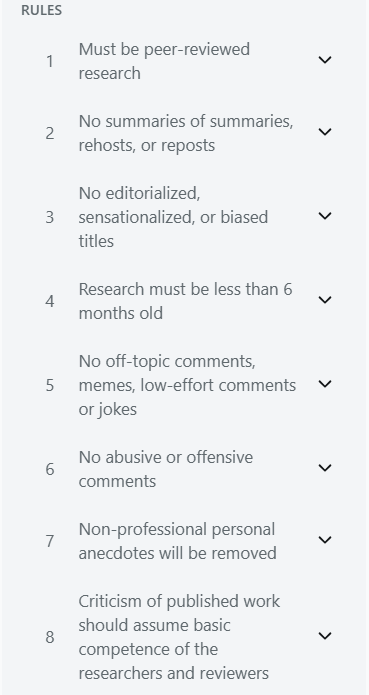
An easy dos and don’ts list makes your guidelines more approachable. Instead of lengthy “scroll-wrap” agreements, a quick scan can inform them what’s acceptable and what’s not.
Define your community’s green, yellow and red lights — like traffic lights .
Follow a clear structure to bring in clarity:
- The green (the ideal behavior) – This could be respectful interactions, respecting others’ privacy, etc.
- The red is (what’s not allowed) – The rules & boundaries or prohibited content like spams, hate speech, or offensive messages.
- Add the dire consequences for breaking the rules.
4. Address the Privacy & Security Concerns of the Group
Privacy is an essential element in this “how to create community guidelines guide.”
Protecting your community’s purpose is essential from the ethical, legal, and authority perspective.
Communities are essentially made of diverse audiences. This includes the vulnerable groups at higher risk. Hence, setting up an actionable safety plan is the key to deal with it effectively.
Consider possible scenarios of violations and effective approaches to deal with them.
Cyberbullying, harassment, scams, location tracking are common privacy issues on online communities. Mention in your guidelines that you have zero-tolerance for such behaviour.
Here are a few practices to deal with them:
- Create awareness about such suspicious incidents and how to identify and report them
- Encourage users not to reveal their personal or confidential information
- Create strong passwords and strong authentication mechanisms
5. Specify the Age Limit – who isn’t allowed to access the community
Does your community deal with sensitive topics?
The age limit is a crucial factor. If you don’t want your content to reach minors, mention the age restriction in the guidelines.
You can also create NSFW-content specific restrictions. Subreddits hosting adult content encourage users to tag their suggestive content. This ensures even though your content is explicit, it’s not directly accessible to viewers.
Some adult communities, like OnlyFans and Fansly, have a strict age verification process. Only users over 18 years of age can join the platform. They need to submit their government-issued ID proof and photos for verification.
Clearly state that members shouldn’t have any pornographic intent. The rules should be stringent to keep your community away from legal tussles!
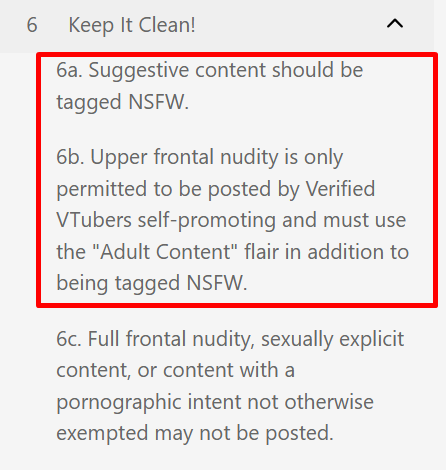
6. Cover the Conflict Resolution & Enforcement Strategies
A friendly chat can take minutes to escalate into a heated debate. Do you have a clear plan for managing your community when things go downhill? That’s what crisis management is all about!
Follow these strategies to manage community conflicts:
-
Identify the source of your problem
People often try to resolve conflicts without delving deeper. Some common conflicts that arise in online communities include differences of opinion, behavioral problems, ego tussles, and privacy issues.
To find a feasible solution, it’s essential to find the reason for the conflict. Brainstorm realistic and feasible solutions to combat the problem. Have a fair dialogue, put them on probation, or directly remove them.
- Set clear field rules
Sometimes, your community guidelines aren’t just clear enough. Explain the rights and wrongs from the outset. Your guidelines should state your values, rules, and mitigation strategies. Pin this as an important post at the top of your community.
-
Active Listening
Sometimes, conflicts appear simple superficially but become tangled as they delve deeper. Active listening makes each voice heard and valued.
-
Mediate Conversations
Interpersonal conflicts can be tricky to settle. The community manager can step in and mediate such situations. View the situation from a neutral perspective to avoid an unbiased outcome.
7. Mention How Members Can Reach You
Whether your members are new or finding a hard time being bullied, they might want to reach you. But they might be confused about whom to contact.
Mention the roles of people who manage the community or a central point of contact. Define different contact points: phone number, direct message, and email address.
You can even create feedback forms to share grievances and concerns. Describe when they can reach the management. A few scenarios are providing feedback, reporting violations, or asking general questions.
8. Promote Diversity, Inclusive, and Safe Environment
Your online community should be welcoming. Everyone must have a voice. One where diverse opinions, voices and experiences are respected.
Encourage members to share their views and opinions. Include positive messaging in your guidelines by highlighting the expected behavior.
Some effective ways to create an inclusive environment are:
- Nurture Differences– Initiate discussions, and host live events or engagement activities to celebrate differences
- Provide Resource & Support – Offer training, mentorship programs, or exclusive content to minority groups. Address concerns of members with prompt action.
- Encourage Members to be their Best Selves – A warm welcome can make members feel at home! Introduce new members in a feel-good way. Create an onboarding form with details like hobbies, a reason to join the group, and candid pics.
- Celebrate Community Heroes – A member spotlight at the end of each month could be a game-changer. You can share it on your community page or newsletters.
- Be the role model– As a community manager, it’s essential to practice what you preach. Lead by example and show the behaviour that you expect from members.
9. Regularly Update and Review Your Guidelines
Communities are made of people. And when people evolve, communities also evolve. When expectations change, conversations shift, the guidelines should also change.
And one of the best ways to update that is actively listening to your members. Create a survey form, open a discussion thread, or dedicated channel for real-time feedback.
Consider these points while updating your guidelines. This makes your community more relevant and user-friendly. You can schedule your review sessions every 4 months or 6 months.
Initially, you can have someone review your guidelines, ensuring you don’t miss the important points.
We have covered the amazing tips on how to create community guidelines!
How to Enforce Your Guidelines?
Your guidelines are not to be etched as the top post in the community.
They need to be followed by your members. A good enforcement strategy increases the likelihood of the rules being followed to the “T.”
Here are some enforcement strategies to create a positive environment:
1. Make Your Guidelines Accessible and Navigable
The first step is to make your community guidelines more noticeable. Place your community guidelines where members can easily spot it. If you host a community on your website, you can easily include it in a downloadable PDF or document.
Alternatively, if you own a social media group, you can make it a pinned post. Create an agreement that members can read and check before joining the community.
2. Include them in the Onboarding Process
Want to ensure every member is aware of the guidelines? Integrate them in the onboarding process if you have one. This would be useful if you are using third-party platforms with custom onboarding settings.
3. Monitor Your Community
The most crucial step is to monitor your community. Keep an open eye on the conversations, activities and all the interactions. Track essential metrics like engagement rate, content performance, and participation.
Community managers can evaluate these factors and make sound, data-driven decisions. Collect feedback from members to understand their needs and preferences.
Real Examples of Community Guidelines(Rules and Key Takeaways)
Creating the community guidelines for the first time?
These stellar community examples show you how to craft empowering guidelines that actually work!
1. Spotify Support Community
In this digital age, Spotify has evolved as a major source of entertainment. It’s a digital streaming service with 675 million active users. The brand has an active support community where members can share ideas, discuss topics, raise product queries, etc.
Guidelines:
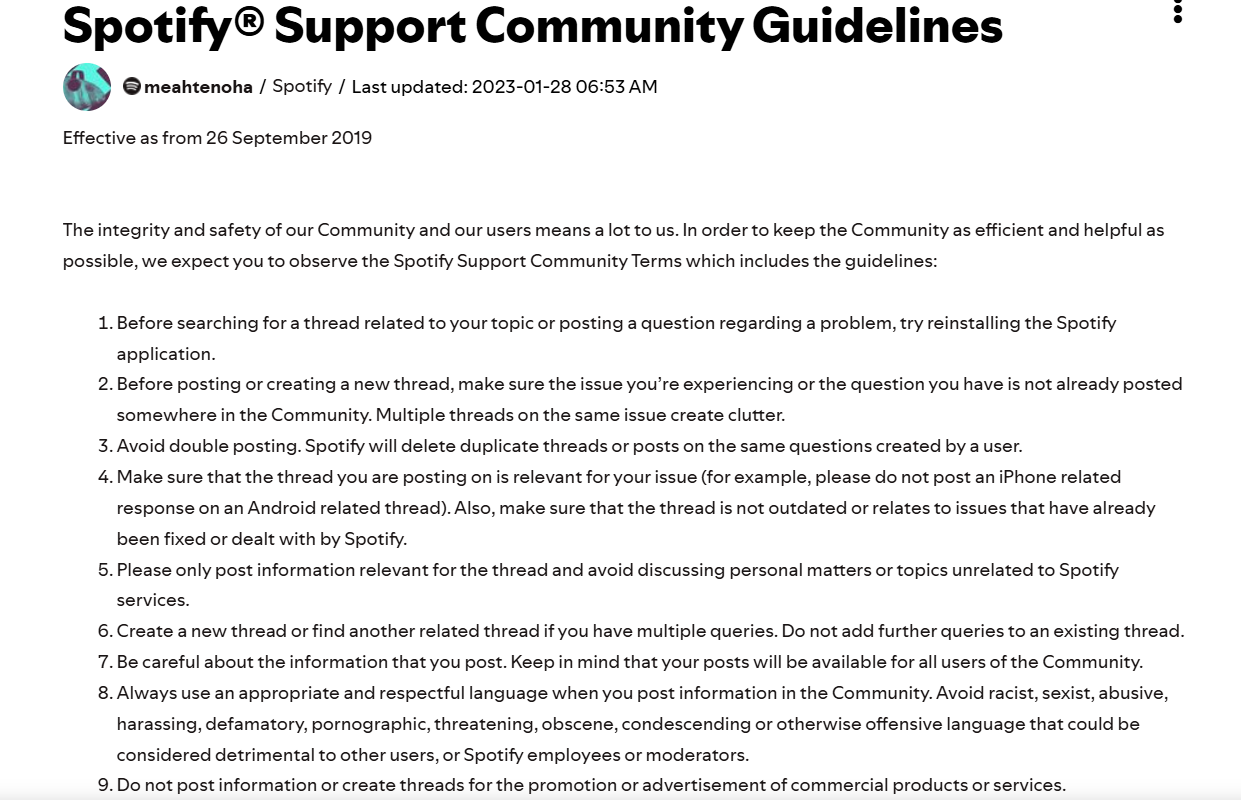
Learning Points:
The community guideline is comprehensive and explained in simple language. It explains what’s allowed and what’s not, how to protect your community’s privacy, and how to report violating content.
Takeaways:
The Spotify community guidelines cover everything community members should know. They focus on how to create relevant threads. The tone is right—informative but not strict.
2. Lego Ideas
Ever thought about how to transform play into inspiration? Then, Lego Ideas shows you how to nail it!
Lego Ideas is an open community for Lego enthusiasts where they can share innovative ideas. Submit a creative Lego idea, win exciting challenges or activities, or vote for your favorite idea. The community is a treasure trove for Lego enthusiasts.
And yes, there are rewards to add more excitement. The winners get to keep 1% of the net sales of the Lego Ideas set.
Guidelines:
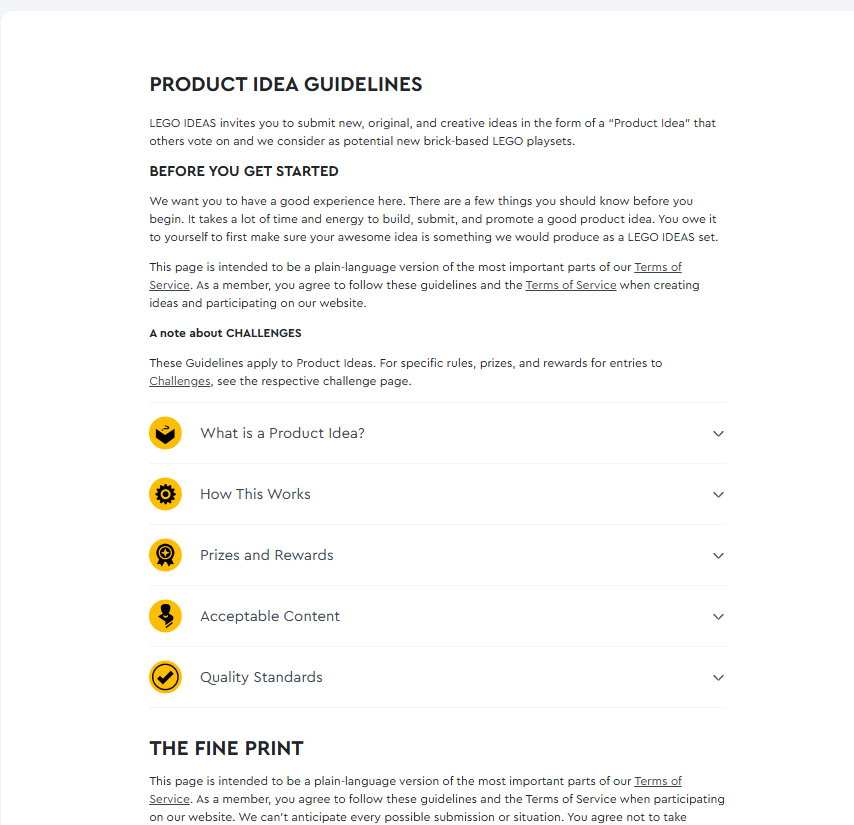
Learning points:
The community is highly creative and enthusiastic. The guidelines reflect a place bustling with ideas, perspectives, and inspiration.
The set of community guidelines include:
- What’s an ideal Lego product idea
- The proposal submission process
- Acceptable content
- Content Quality
- Prizes & Rewards
Takeaways:
The language is plain English and easy to understand. If you are creating a community to drive inspiration, this guideline would be helpful. The tone and content is encouraging and clearly explains the ideas they are looking for.
3. Reddit -r/funny
One of the largest subreddits – r/funny, is a sprawling community of 67 million members. Founded in 2008, the community includes all things humorous. From trending videos, meme jokes, viral jokes, a quick scroll is sure to leave you in splits.
Guidelines:
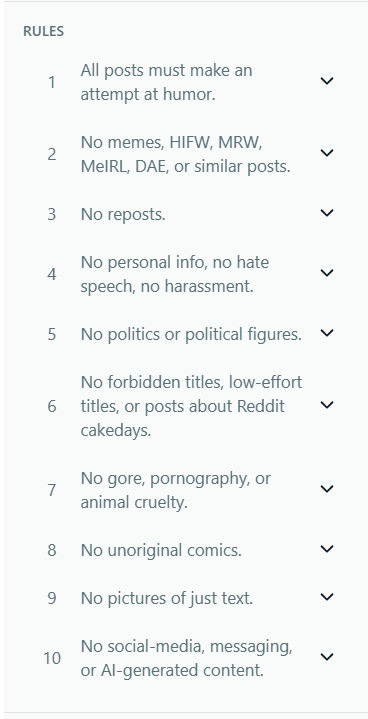
Learning Points:
The community guideline is simple and lucid. If you are creating a similar subreddit group for entertainment, this guideline is worth considering. The guideline covers everything: what’s allowed, what’s not allowed, privacy, etc.
Takeaways:
Creating community for the first-time? If your community is lighthearted, you can keep your guidelines simple and one-liners.
Community Guideline Template
Introduction
Welcome to the [community],
The goal of our community is to [Community Purpose, Mission, Core Values]
[How does your community work?]
Acceptable/ Positive Behaviour- What we encourage:
- Respectful communication
- Be polite and kind towards other members
- Respect the privacy and security of other community members
Content Standards
- Create relevant content
- Types of acceptable content
- Avoid self-promotion, politics or controversial topics
Rules & Restrictions – What we discourage
- Don’t post spam posts
- No discrimination, violence, or hate speech is allowed
- No illegal or explicit content is allowed
Conflict Resolution Framework
This community is created to be a safe space for members.
Any behavior that is conducive to a safe environment could be grounds for removal from the community.
If you receive an appropriate message, click report and let us know.
If you find an inappropriate post, click on the three dots and report the inappropriate content.
Privacy & Safety Concerns
- Create a safe and secure environment.
- Don’t share posts without permission.
- Share original ideas, and avoid plagiarized content.
- If you share any stock images, music, videos, or any copyrighted material, give credit to the author.
Contact Information
Please reach out to us at [email id] or [contact info] to address any concerns or questions.
Final Few Words
A community guideline is a lighthouse to help members navigate through a group. The touchstone – that guides on what’s allowed and also defines red flags of violation.
Above all, it helps to create safe, inclusive, and nurturing spaces for growth.
In this blog, we have covered strategies on how to create community guidelines with examples. To start with, you can use our template as a basic framework. Later, add essential touchpoints to tailor it as per your community needs.
Have an actionable plan to put your guidelines into practice! Is there something that worked for your community? Let us know in the comments, if there’s an amazing tip you want to share! Good Luck!
FAQs Related to How to Create Community Guidelines
1. Why create community guidelines?
Community guidelines are essential to create a welcoming, safe and healthy environment. It creates a positive and safe environment for community members to grow.
2. How do we make effective community guidelines?
To make effective community guidelines:
- Take the Opinion of Community Members
- Start with the community mission & goals
- Set the Transparent Rules and Expectations
- Address the Privacy & Security Concerns of the Group
- Specify the age restrictions for joining the community
- Cover the Conflict Resolution & Enforcement Strategies
- Mention your contact information in the guidelines
- Promote diversity, safety and an inclusive environment
- Regularly update & review your guidelines
3. What is the difference between a community moderator and a manager?
While the moderator manages the day-to-day tasks, such as approving posts, addressing conflicts, etc. A community manager focuses on long-term vision and growth. This involves content calendars, how to engage the audience, brand loyalty, etc.

